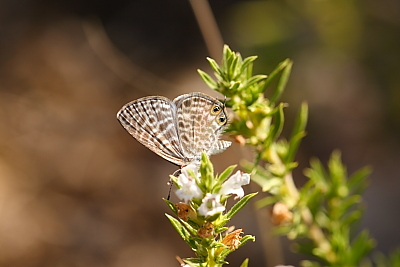









Lang's Short-tailed Blue (Leptotes pirithous)
2024 photographs highlighted in yellow. Click on any photograph to go to an enlarged picture, or simply scroll down the page.
|
Before 2006 I had only seen pirithous in odd ones and twos, mostly in Var but also in Ariège in the Pyrénées. However, spending the whole of September in 2006 (and every subsequent year) in the southern part of Var, I was amazed at the numbers - there seemed to be one every few metres in places. They seemed to be more common on cultivated flowers, especially in gardens, than in the wild. As the numbers seemed to build up very quickly from mid-September onward (and well into October) and many seemed quite worn, it suggested that this was the result of migration rather than an emergence of a second brood.
However, in 2007 many appeared very fresh, so I'm fairly sure there is a second brood, which is perhaps augmented by migrants. Since then I have rarely seen a first brood pirithous nor a fresh pirithous in September, suggesting maybe that most are migrants. |
They can be quite sedentary when feeding, so can easily be missed. Also the rather indistinct underside markings (photographs always seem to appear slightly out of focus) make it hard to spot, relieved only by the two magnificent unh spots - the silver edging is more visible in the enlarged photographs. I also think it's mis-named as the tails are actually not short at all. It could easily be confused with the Long-tailed Blue (Lampides boeticus) which it superficially resembles; the key differences are outlined on the boeticus page.
The male upperside is rather dull by comparison to its more illustrious cousins, and lacks the upf markings of the female which, as is usual for blues, is brown with a limited number of blue scales in the basal area. It was only in 2023 that I managed to achieve a photograph of the male upperside. |
| ref | sex |
observations |
alt. m |
| 51059 | M | a rather poor shot, but it is the only upperside image of this species that I have managed, and this only a brief opening of the wings. It does show (just) the deep blue colouration, constant across both wings. 51061 is the underside. | 370 |
| 5613 | F |
this female is quite dull even by the standards of the upperside of this rather drab butterfly, but this could be the result of age rather than the lack of original blue scales. |
185 |
| 19523 | F |
if 5613 is a drab female, 19523 is even duller by comparison, all the blue scales (if there ever were any) have long since disappeared. |
60 |
| 39385 | F | this female appears to be fresh, judging by the integrity of the margins. | 60 |
| 51061 | M | the underside of 51059, quite boldly marked by the standards of pirithous. | 370 |
| 51999 | M | a male, with a rather more reddish-brown colouration than most. | 60 |
| 6341 | M |
this male is puddling, not something I have often seen pirithous do. The underside is better contrasted than most. The two unh marginal spots are clearly visible, with the magnificent circles of silver and orange. |
200 |
| 35369 | M | a male. | 200 |
| 9388 | F |
I believe this to be a female based on body shape, but am not totally convinced. |
780 |
| 49343 | F? | this could be a female, but the body shape in very inconclusive. The pattern is quite light, almost to the point of appearing out of focus. | 200 |
51059_male_Bouches du Rhône_30Jun23
51061_male_Bouches du Rhône_30Jun23